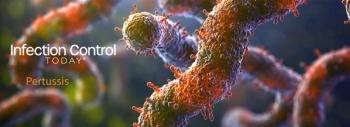
Hot Topics in Infection Prevention: COVID-19, Ebola Outbreak, and Ocular and Needlestick Monkeypox
Saskia v. Popescu, PhD, MPH, MA, CIC, covers updates on COVID-19 in frontline workers, an Ebola outbreak in Uganda, and ocular and needlestick monkeypox.
COVID-19 infection
A
What did they find? During this long study period, most individuals were infected with Omicron (62%), and per the investigators, “Participants vaccinated with the second vaccine dose 14 to 149 days before Delta infection were significantly less likely to be symptomatic compared with unvaccinated participants (21/27 [77.8%] vs 74/77 [96.1%]; odds ratio (OR), 0.13 [95% CI, 0-0.6]) and, when symptomatic, those vaccinated with the third dose 7 to 149 days before infection were significantly less likely to report fever or chills (5/13 [38.5%] vs 62/73 [84.9%]; OR, 0.07 [95% CI, 0.0-0.3]) and reported significantly fewer days of symptoms (10.2 vs 16.4; difference, −6.1 [95% CI, −11.8 to −0.4] days).”
This means that asymptomatic cases were more closely linked to Omicron infections. Of those with symptoms, the longest duration was for those with Delta—16.4 days. Workers with a second vaccine dose prior to a Delta infection were much less likely than those unvaccinated to have symptoms. For those individuals with 3 doses and ended up experiencing symptoms, they were less likely to experience a fever or chills and, ultimately, had symptoms for fewer days. Last little tidbit, with Omicron-infected workers, that third dose made a much more significant difference in ensuring mild symptoms, and ultimately, they found that those symptomatic participants had much higher viral loads than those asymptomatic cases. The lowest viral loads? Workers who were given their second dose and had either Delta or Omicron infections when compared to their unvaccinated counterparts.
Ebola Outbreak in Uganda
Total cases are now at 80 with 44 deaths. Uganda’s Health Ministry has initiated a 3-week lockdown for 2 districts most heavily impacted, and there has been a new isolation facility established in Madudu with support from partners like Doctors Without Borders. Stay vigilant, folks: Relevant travel and symptoms will be key as this is the Sudan strain, and there are no vaccines or treatments approved for it.
Ocular and Needlestick Monkeypox
In not particularly surprising, but nonetheless important news, the Centers for Disease Control and Prevention has
Newsletter
Stay prepared and protected with Infection Control Today's newsletter, delivering essential updates, best practices, and expert insights for infection preventionists.






